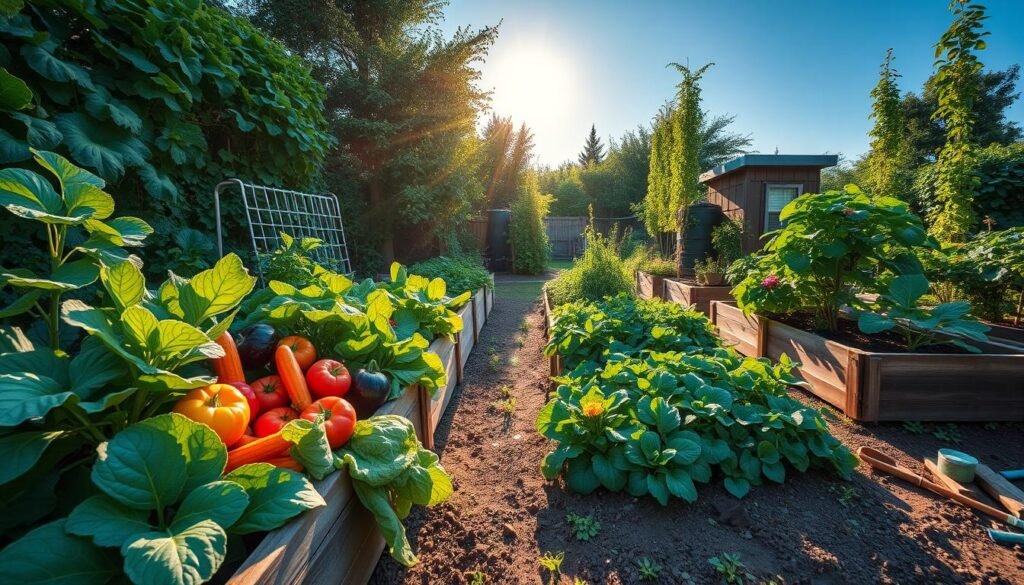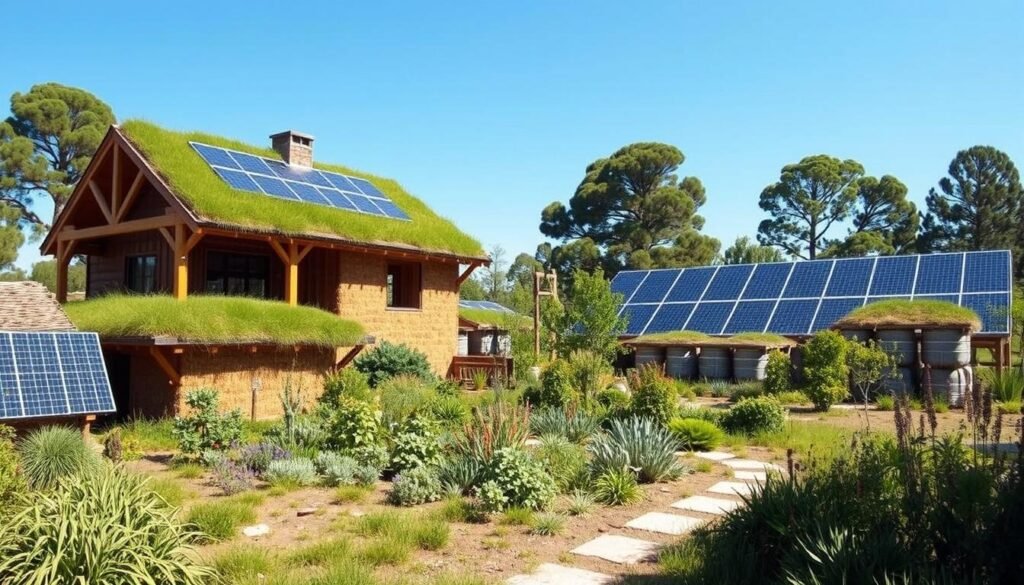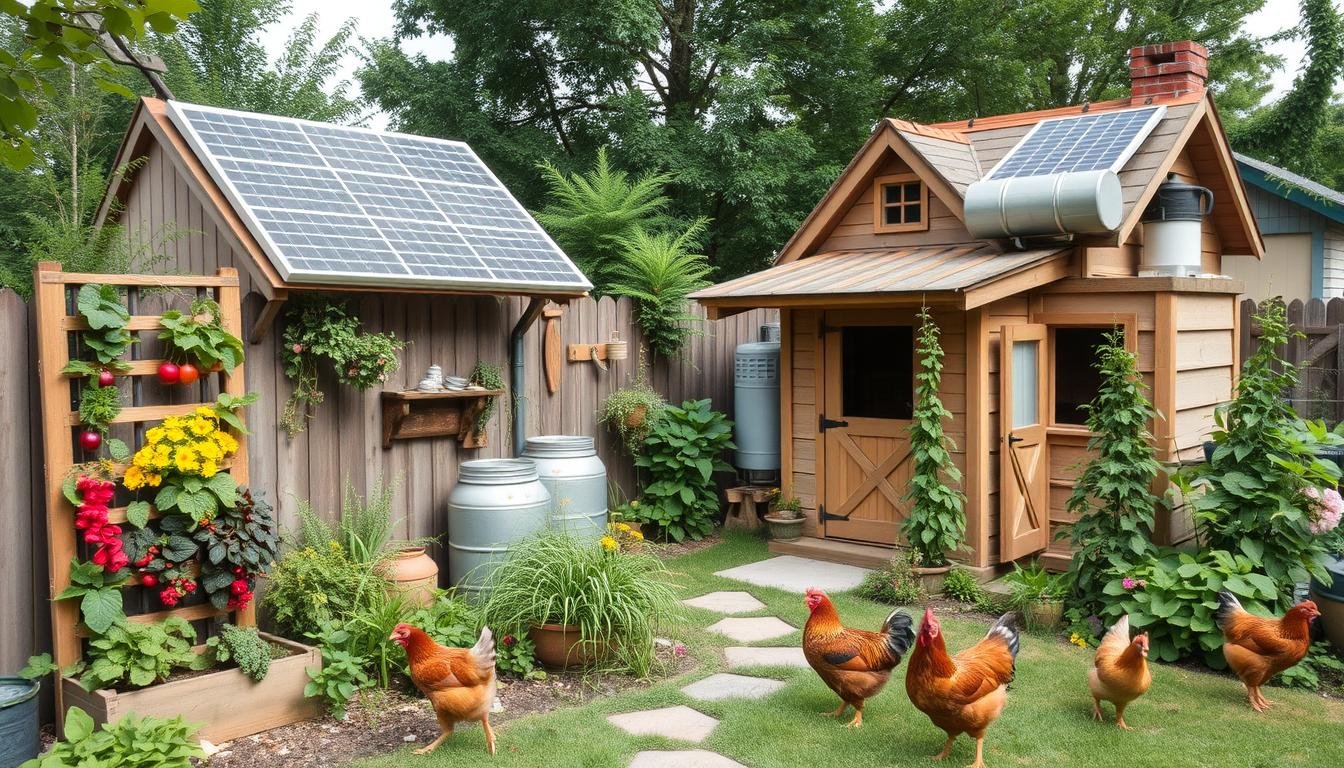Imagine standing in your backyard, feeling the sun’s warmth, and looking at the garden you made. You feel proud knowing you’re living more sustainably. This journey is about cutting down on carbon emissions and finding purpose and connection.
Starting DIY self-sufficient home projects can make your home greener. You can use renewable energy and grow your own food. These projects lead to a better life and a greener planet. Let’s see how you can make your home a sustainable place, one project at a time.
Sustainable living is crucial today. By doing eco-friendly projects, you lower your environmental impact and learn new skills. Imagine eating food from your garden or feeling safe during power outages.
Did you know better insulation can cut your energy bills by over 50%? Or a solar water heater can lower your energy costs? These are just a few ways DIY projects help your wallet and the planet.
Key Takeaways
- DIY self-sufficient projects can significantly reduce energy bills and environmental impact
- Solar panel installation for a two-story home costs between $14,000 to $20,000
- 45% of popular DIY projects involve gardening-related activities
- Food preservation techniques account for 18% of sustainable living projects
- Implementing sustainable practices can lead to a more fulfilling and self-reliant lifestyle
Starting your journey to a sustainable home is exciting. Every small step matters, whether it’s a rain barrel or solar panels. Each project moves you closer to living self-sufficiently. Let’s get started and make our homes a symbol of sustainable living.
Understanding Self-Sufficiency in Home Living
More people are choosing eco-friendly homes and off-grid living for self-sufficiency. This lifestyle brings many benefits and follows key principles. It promotes sustainability and independence.
Definition of a Self-Sustaining Home
A self-sustaining home uses less external resources. These homes make their own power, use water wisely, and may grow their own food. The aim is to be as independent as possible from public utilities and supply chains.
Benefits of Self-Sufficient Living
Living self-sufficient through homesteading has many perks:
- Lower utility bills
- More energy independence
- Better food security
- Less environmental impact
- More resilience to disruptions
Key Principles of Sustainable Home Projects
To make a self-sustaining home, follow these principles:
| Principle | Implementation | Impact |
|---|---|---|
| Energy Efficiency | Solar panels, better insulation | 60% less energy used |
| Water Conservation | Rainwater collection, greywater systems | Less strain on water sources |
| Food Production | Gardens, small livestock | More food security, less food miles |
| Waste Reduction | Composting, recycling | Less waste in landfills |
By using these principles, you can make a home that’s good for the environment. It will also be more resilient and save money over time.
Energy Independence: Harnessing Renewable Power
Living off-grid and building sustainable homes means being energy independent. Using renewable energy cuts down on carbon emissions and lets you control your power. Let’s look at some top ways to get clean energy at home.
Solar Panel Installation Basics
Solar power is great for homeowners wanting energy freedom. Thanks to new tech, solar panels work better and are cheaper. Installing them on a two-story house costs between $14,000 and $20,000. But, doing it yourself can save you a lot of money.
Solar panels lessen your need for the grid and can even make your home worth more.
DIY Wind Turbine Projects
Wind power is another good choice for off-grid living. Small wind turbines are affordable and perfect for many uses, like pumping water on farms. They can be tricky because of the wind’s unpredictability and the land you need. But, they work well with solar power in a mix.
Micro-hydro Power Systems for Homes
If your property has flowing water, micro-hydro power systems are a solid choice. They can make up to 100 kilowatts of electricity, enough for a big home. Micro-hydro is great when putting in regular power lines is hard or too costly.
| Renewable Energy Source | Pros | Cons |
|---|---|---|
| Solar Power | Adaptable, scalable, reduces carbon footprint | Requires battery storage, dependent on sunlight |
| Wind Power | Cost-effective, diverse applications | Wind variability, land requirements |
| Micro-hydro Power | Reliable, efficient for large homes | Limited to properties with flowing water |
By using these renewable energy sources together, you can make a strong, self-sufficient power system for your home. Always check local laws and safety rules before starting your energy independence project.
Water Conservation and Management
Water conservation is key for a sustainable life. Start by using rainwater harvesting and gray water systems at home. These methods cut down on municipal water use and make water use more efficient.
Rainwater harvesting means collecting and storing rain for later use. You can turn your gutters into a water collection system with rain barrels. This is great for places like Portland, Oregon, which gets about 36 inches of rain a year.
Gray water systems use household wastewater for things like watering plants or cleaning. Using these systems can greatly reduce your water use and lower your bills.
“Water is a precious resource. Every drop saved counts towards a sustainable future.”
The Richmond Residence in Portland is a great example of smart water use. It has a 9,000-gallon cistern that provides all the drinking water it needs through rainwater. Plus, it uses drought-resistant plants to cut down on watering.
| Water Conservation Method | Potential Savings |
|---|---|
| Rainwater Harvesting | Up to 100% of potable water needs |
| Gray Water Systems | Up to 30% of household water use |
| Low-Flow Fixtures | 20-60% reduction in water use |
| Drought-Tolerant Landscaping | 30-60% reduction in outdoor water use |
By using these water-saving methods, you can really cut down on your water use. This helps you live more sustainably.
Sustainable Food Production at Home
Growing your own food is key to homesteading and living off the land. With food prices going up, many are choosing organic gardening for fresh, healthy food. Let’s look at some easy ways to start your sustainable food journey.
Starting a Vegetable Garden
Start your permaculture journey by planting vegetables you love to eat. A small quarter-acre can feed a family. Pick a spot that gets a lot of sun and has good soil. Tomatoes, lettuce, and peppers are easy to grow for beginners.

Building a Greenhouse
A greenhouse lets you grow food longer, even in cold places. It keeps plants safe from bad weather and pests. You can make a simple one with old materials or buy a kit.
Composting Techniques for Nutrient-Rich Soil
Composting is key for organic gardening. It turns kitchen scraps and yard waste into great soil. Begin with a basic bin or pile, mixing food scraps with leaves and paper. Mix it well and turn it often for faster breakdown.
| Composting Material | Carbon-to-Nitrogen Ratio | Decomposition Time |
|---|---|---|
| Fruit and vegetable scraps | 25-40:1 | 1-2 weeks |
| Grass clippings | 15-25:1 | 2-4 weeks |
| Leaves | 30-80:1 | 6-12 months |
By using these homesteading tips, you’re not just growing food. You’re building a sustainable life. Start small, learn as you go, and enjoy what you grow!
Waste Reduction and Recycling Systems
Living sustainably means reducing waste to zero. Start by recycling and upcycling. Use separate bins for paper, plastic, and glass to make sorting easy. Composting food scraps helps reduce landfill waste and makes great soil for your garden.
Upcycling is fun and gives old items new life. Use empty jars for storage or turn wooden pallets into furniture. This reduces waste, saves money, and adds style to your home.
Make your own natural cleaners with vinegar, baking soda, and essential oils. This reduces plastic waste and harmful chemicals at home. Using reusable items like cloth napkins and glass containers also helps.
“Reducing waste isn’t just good for the planet – it’s good for your wallet too!”
By using these strategies, you’re moving towards a sustainable lifestyle. Every small action helps in the journey to zero waste living.
| Waste Reduction Strategy | Benefits |
|---|---|
| Composting | Reduces landfill waste, creates rich soil |
| Upcycling | Saves money, reduces new product demand |
| Homemade cleaners | Reduces plastic waste, less harmful chemicals |
Self-Sufficient Home Projects for Beginners
Starting with DIY projects for sustainable living is easy. Begin your path to eco-friendly homes with simple yet effective steps. These projects boost your sustainable lifestyle and teach you valuable skills.
Rain Barrel Installation
Rain barrels are a great first step in saving water. They catch rainwater for your garden or other uses. This easy project cuts down your water use, especially in dry areas.
DIY Solar Oven Construction
Building a solar oven is a fun way to use renewable energy. These ovens cook food with sunlight, cutting down on traditional energy use. It’s a fun way to cook sustainably and enjoy the outdoors.
Creating a Vermicomposting Bin
Vermicomposting turns food waste into garden gold. By using a bin for worms to break down organic matter, you get rich compost. This project helps reduce waste and boosts your gardening.
| Project | Cost Range | Time to Complete | Sustainability Impact |
|---|---|---|---|
| Rain Barrel Installation | $50 – $200 | 2-4 hours | High water conservation |
| DIY Solar Oven | $30 – $100 | 3-6 hours | Reduces energy consumption |
| Vermicomposting Bin | $20 – $80 | 1-2 hours | Effective waste reduction |
These easy projects are just the beginning of your sustainable living journey. As you get more confident, you can tackle more complex DIY projects to make your home even greener.
Advanced DIY Projects for Eco-Conscious Homeowners
Are you ready to improve your sustainable building skills? Advanced DIY projects can make your off-grid living better and boost your renewable energy. These projects need more knowledge but give big rewards in being self-sufficient.
Installing a full solar panel system is a big project. It can cut your electricity bills and lessen your need for the grid. DIY solar panels can save you money, with some homeowners seeing up to 90% less in energy costs.
If you live in a windy area, building a wind turbine is a great idea. Wind power works well with solar energy, giving you power on cloudy days. A well-made turbine can make a lot of electricity for your home.
Having a stream on your land? Think about making a micro-hydro power system. This steady source of renewable energy can power your home all day, every day. It’s perfect for off-grid living.
- Wood-fired hot tub: Enjoy relaxation while using renewable resources
- Clay domed pizza oven: Perfect for outdoor cooking enthusiasts
- Natural swimming pool: Use reed beds for natural filtration
These projects increase your self-sufficiency and add special features to your home. Always plan carefully and follow safety rules when doing advanced DIY projects. With hard work and skill, you’ll be surprised at what you can do in sustainable building and energy production.
Sustainable Building Materials and Techniques
Creating eco-friendly homes begins with picking the right materials and methods. Sustainable building uses recycled materials and new construction ways to lessen harm to the environment.
Reclaimed Wood Projects
Reclaimed wood is a top pick for green building. It’s great for floors, furniture, or walls. Using recycled materials like this adds charm to your home and helps save trees.
Earthbag Construction Basics
Earthbag building is affordable and green. It stacks bags filled with soil or other stuff for strong walls. Perfect for living off the grid, it needs few special tools.
Straw Bale Building Methods
Straw bale building is great for insulation and uses waste from farms. It’s a natural way to build sustainably. Bales are stacked and plastered over for a strong, energy-saving home.

- Use local materials to reduce transportation emissions
- Install high-performance windows to save energy
- Choose recycled steel or drywall for construction
- Opt for eco-paints to improve indoor air quality
| Material | Benefits | Energy Savings |
|---|---|---|
| Reclaimed Wood | Reduces deforestation, unique aesthetic | 15-20% |
| Earthbags | Low-cost, durable, fire-resistant | 30-40% |
| Straw Bales | Excellent insulation, uses agricultural waste | 50-60% |
By using these green building materials and methods, you’re doing more than building a home. You’re helping make the future greener. Even small changes in building can make a big difference for the environment and save energy over time.
Off-Grid Living: Essential Skills and Knowledge
Living off the grid needs a lot of skills and knowledge. People who want to be self-sufficient are often motivated, think critically, and solve problems. To do well in homesteading and permaculture, you must learn many skills.
To learn these skills, you can take classes, read books, join co-ops, and go to workshops. Many start with simple building projects. These projects can make you feel empowered on your path to self-sufficiency.
Key areas to focus on include:
- Energy management (solar panels, wind turbines)
- Water conservation (wells, rainwater harvesting)
- Food production and preservation
- Basic repair and maintenance
- Animal husbandry
Starting off-grid living has different costs. Building a home can begin at $70,000. You’ll also spend money on water and electricity systems. For heating, you can use fireplaces, wood-burning furnaces, or thermomass systems.
Being self-sufficient with food means gardening, foraging, and preserving food. You can do this through canning, pickling, and fermenting. Raising animals like chickens, ducks, and goats gives you eggs, dairy, and meat.
“Off-grid living is about mastering diverse skills and embracing a sustainable lifestyle.”
| Skill Area | Examples |
|---|---|
| Energy | Solar panel installation, wind turbine maintenance |
| Water | Well digging, rainwater collection, filtration systems |
| Food | Organic farming, foraging, food preservation |
| Construction | Basic home repairs, sustainable building techniques |
| Animal Care | Chicken raising, goat milking, beekeeping |
Integrating Technology in Self-Sufficient Homes
Smart home technology can change how you live self-sufficiently. Using IoT devices and sustainable tech helps you use less energy and lessen your impact on the planet.
Smart Home Automation for Energy Efficiency
Smart thermostats are key to better energy use. They learn your habits and adjust the temperature for you, which can cut your bills. LED lights controlled by your phone use much less power than old bulbs, making your home more efficient.
IoT Devices for Sustainable Living
IoT devices are vital for green homes. Appliances with the ENERGY STAR® label use less water and energy. Smart fridges, washing machines, and dishwashers use fewer resources but work better.
Open-Source Technologies for Self-Sufficiency
Open-source tech gives you control over your eco-friendly home. You can set up systems to monitor your energy use and find ways to save. Automated watering systems help your garden grow well, cutting down on water and food waste.
“Smart home technology offers endless possibilities for a sustainable lifestyle with enhanced comfort, convenience, and savings.”
By using these technologies, you’re not just making your home smart. You’re building a future that’s good for the planet. With the right setup, you can use less energy, reduce your carbon footprint, and save money over time.
Community Engagement and Sustainable Living
Living sustainably doesn’t mean going it alone. By connecting with others, you can create eco-friendly communities and sustainable neighborhoods. Sharing knowledge and resources with like-minded people makes your journey towards self-sufficiency more rewarding.
Community gardens are a great way to get involved. These spaces let people grow food, learn new skills, and make friends. You can also join seed exchanges or tool-sharing programs. These activities reduce waste and build community spirit.
Organizing workshops is another way to spread sustainable living skills. Teaching others lets you share your knowledge and learn from your neighbors. This exchange of ideas can lead to new solutions for local problems.
Benefits of Community Engagement
- Shared resources and reduced costs
- Increased resilience through mutual support
- Opportunities for larger collaborative projects
- Improved quality of life for all residents
In Antony, France, a project let residents decide how to spend a budget. They chose to plant a microforest, start a collective garden, and document local wildlife. This shows how community involvement can lead to sustainable projects.
| Project Type | Community Benefits |
|---|---|
| Community Gardens | Fresh produce, social connections, skill sharing |
| Tool-Sharing Programs | Reduced consumption, cost savings, resource efficiency |
| Sustainability Workshops | Knowledge exchange, skill development, community bonding |
By taking part in your community, you help build a network of self-sufficient homesteaders. This network offers support, inspiration, and chances for working together. It makes sustainable living easier and more fun for everyone.
Conclusion
Living sustainably and doing self-sufficient projects can change your home for the better. This guide has shown you ways to live greener and rely less on others. By following these tips, you’re making a big difference for the planet and for yourself.
Starting to be self-sufficient is a journey. Every little step you take helps make the future greener. For example, solar panels can boost your home’s value by $15,000. And using less water can save up to 30% of it.
It’s true, becoming fully self-sufficient is hard. Even experts might only have enough veggies for 10-11 months from their gardens. But every bit you do helps. Start with small steps, learn as you go, and enjoy making your home better for the earth and your family.


